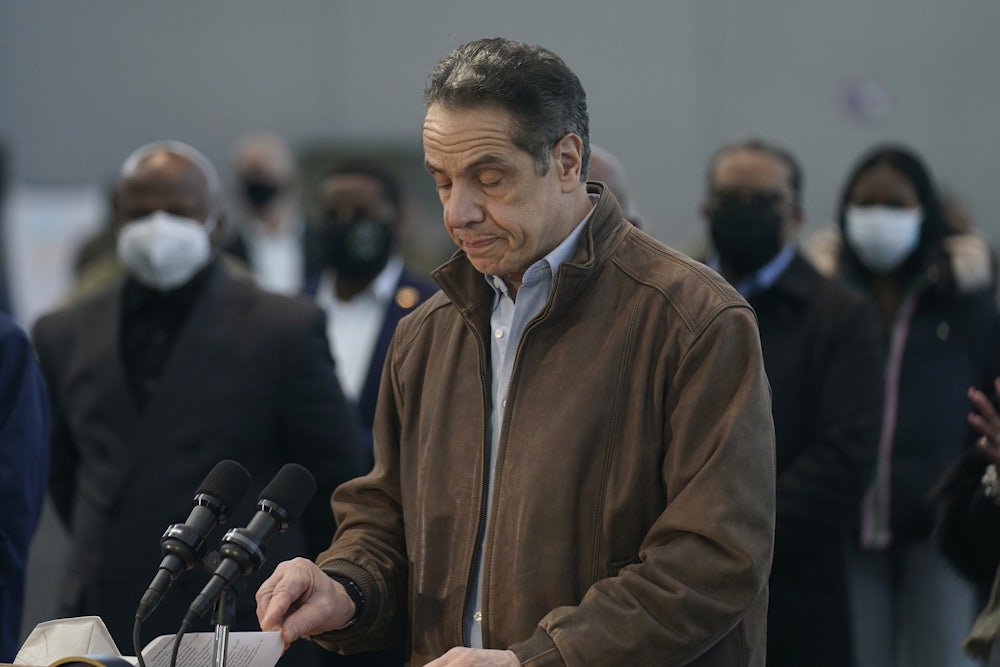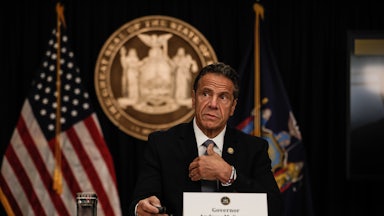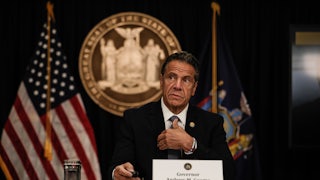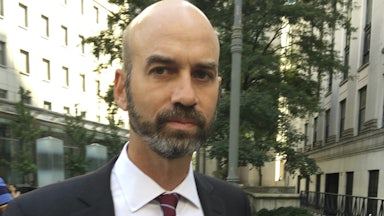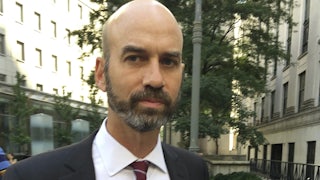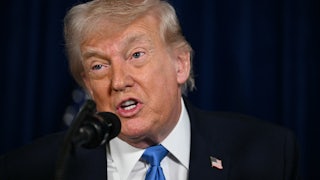New York Governor Andrew Cuomo is facing the densest thicket of scandals to ensnare any American politician since—well, the end of the Trump administration less than two months ago. Even so, the litany of allegations he’s facing is remarkable: the alleged assault or harassment of at least six women and an alleged cover-up of nursing home coronavirus deaths that is now the subject of a federal investigation. A state impeachment inquiry began last week, and well over a hundred local, state, and federal lawmakers, including the majority of New York’s House delegation, Senator Kirsten Gillibrand, and Senate Majority Leader Chuck Schumer, have called for his immediate resignation. In a Tuesday interview on ABC News, President Joe Biden said that Cuomo should resign if the sexual harassment allegations against him are confirmed, adding, “I think he’ll probably end up being prosecuted, too.”
He’s also seemingly lost the press, including the palpably disappointed New York Times, which conceded in a strange and sullen editorial on Saturday that Cuomo’s “considerable political talents” and understanding of “how to make government work” had “translated into a ruthlessness and power that Mr. Cuomo failed to control.” Cuomo, it suggests, is simply too strong, capable, and decisive for his own good—not some mere thug who stands accused of groping a woman and fudging Covid-19 deaths but a superhero who’s forgotten himself and tugged a car door clean off.
But alas, New York’s politicians haven’t been as understanding. And absent a “robust explanation” for the allegations being leveled against him, the Times fears that Cuomo will have to step down. “At this point,” it concludes, “it is hard to see how Mr. Cuomo can continue to do the public’s important business without political allies or public confidence.”
Actually, the public still likes Cuomo just fine. According to a Siena poll released Monday, 50 percent of the state’s voters want him to stay in office while just 35 percent want him to step down immediately. Why might that be? In its editorial, the Times notes that while Cuomo has long been known to politicos as a bully, “the public caught only a glimpse of the dangers of Mr. Cuomo’s behavior recently.” If that’s so, we should consider what those responsible for giving the public its glimpses of Cuomo have been up to over the past year.
In a piece last March, the Times’ Jesse McKinley and Shane Goldmacher wrote that Cuomo’s personality and habits had made him the “Politician of the Moment”: that is to say, the breakout star of our national Covid crisis. “The same blunt and sometimes paternalistic traits that have long rubbed his critics raw,” they said, “have morphed into a source of comfort.” And while acknowledging that Cuomo had been slower than California Governor Gavin Newsom to close nonessential businesses and issue a shelter-in-place order, they focused substantially on his appearances on television. “Mr. Cuomo’s daily addresses have stood in stark contrast to the sometimes contradictory pronouncements coming from Washington.”
This report was preceded by a piece by Ben Smith that ran exactly one year ago Tuesday. Its title: “Andrew Cuomo Is the Control Freak We Need Right Now.” The Times’ subhead laid it on thick: “In ordinary times, Mr. Cuomo’s relentlessness and bullying drive New Yorkers crazy. In the age of the coronavirus, they soothe our battered nerves.” The body of Smith’s column goes on to describe Cuomo as an avuncular and empathetic TV presence who “publicly worried over his daughters and his 88-year-old mother.” It also contended that he was “the executive best suited for the coronavirus crisis,” especially in comparison to Trump and New York City Mayor Bill de Blasio. “The governor has been the clearest and most decisive of the three, relentless behind the scenes and open about the risks,” Smith wrote. “Even many of his critics say the very qualities that make him abrasive in ordinary interactions are serving him well now.”
But Cuomo’s substantive handling of the pandemic—even setting aside the nursing home scandal—has plainly been fair at best. While New York was among the first states to issue a stay-at-home order and close nonessential businesses, it was nevertheless slower to do so than both experts and the anxious thought prudent. Facing pressure to respond aggressively more than two weeks after the state’s first confirmed case, Cuomo refused, saying that he was “as afraid of the fear and the panic as I am of the virus.” He changed his mind not long afterward, and the state shut down with more than 7,000 recorded cases. Cuomo’s subsequent decision, forcing nursing homes to take in former coronavirus patients, probably added somewhat to the more than 14,000 deaths the state has seen in its long-term care facilities since. Concern that it did may have prompted Cuomo’s aides to rewrite an official count of nursing home deaths.
It is true, though, that Cuomo did a decent job at presenting an array of charts, filled with figures that had been derived by other people, in briefings last year. At the evidently herculean feat of delivering clearer information about the pandemic than Donald Trump, he excelled. Of course, there was also the public worrying about his dear mother and all the rest of his shtick that he knew would kill with voters and the press.
As The New York Times, revisiting those early days of the pandemic, reported on Saturday, Cuomo followed the responses to his conferences with a keen interest. “He would sometimes quiz aides as soon as he ended a broadcast about which networks carried him live and exactly when they cut away,” the Times’ Goldmacher wrote, “data they were expected to have at their fingertips.” The rest of the piece reports that Cuomo’s traits “are now being seen in a different light”—the destructive habits of “an image-obsessed politician who has long devoured almost everything written about him,” one whose downfall has been “foretold in a decade-long reign of ruthlessness and governance by brute force.”
Where was all this in the spring of the Cuomosexual? While the Times has been more sober in its assessments of Cuomo than others, offering critical reporting on his handling of the pandemic, the extraordinary amount of praise and credit Cuomo received from the paper for his briefings and public persona over the course of last year should be scrutinized and explained. He can surely be understood, in part, as one of the last in a line of narrative foils for Donald Trump—James Comey, Robert Mueller, Dr. Anthony Fauci to an extent—that the press zeroed in on over the course of his administration. And the public naturally appreciates a seemingly steady hand behind the wheel in a crisis.
But the Cuomo boomlet also points to the broader role personalities play in our politics. Cuomo is a textbook example of a very specific political archetype that is no longer as fetching as it once was—the Democratic bully capable of burying the psychosocial insecurities the right likes to dredge up about liberal politics under a brusque, stereotypically masculine affect. About half a century ago, we had LBJ. Today, we have Cuomo and comparable figures like Rahm Emanuel, whose effort to import military machismo into the Democratic Party lives on in dubious campaigns to this day.
Those who believe in this archetype tend to ascribe political success to personal character and will. In its editorial, the Times writes that Cuomo’s talents were used to “great effect” in persuading “the State Legislature to legalize same-sex marriage, pass strong gun-control legislation and raise the minimum wage.” But these are policies that have been implemented in many places by many kinds of politicians, including figures much less toxic and mendacious than a man who is now—laughably and predictably—dismissing the credible allegations against him as an episode of “cancel culture” instigated against a political outsider. For the last four years, Democrats wondered aloud how voters and figures on the right could bear this kind of thing. To their credit, Cuomo is being repudiated more soundly by his party than Trump ever was. But as with Trump, it should be awfully troubling that anyone was ever taken with him in the first place.
